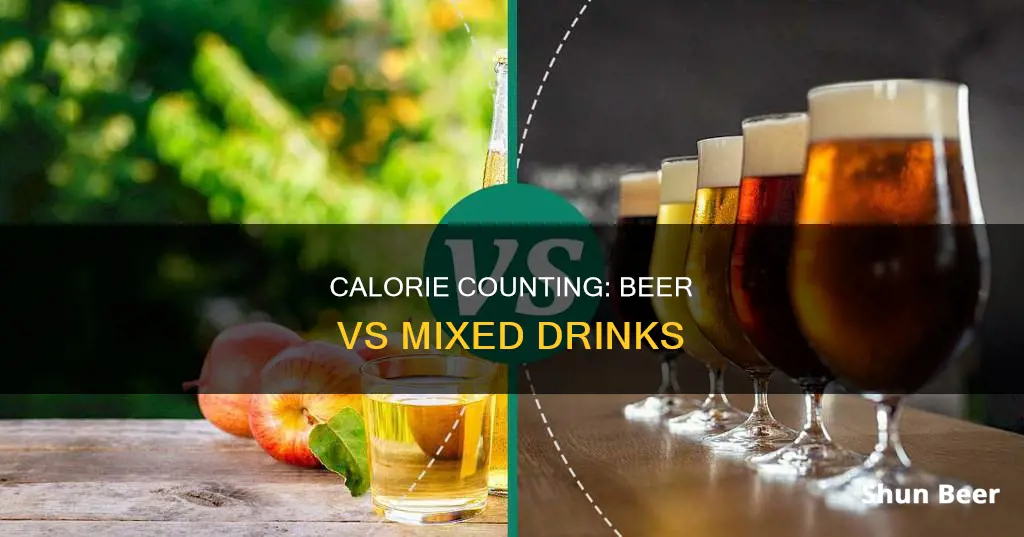
Alcoholic drinks are known to be high in calories, and when it comes to beer versus mixed drinks, the calorie count can vary. A standard 12-ounce beer typically contains around 150 calories, while a 7-ounce mixed drink can have about the same amount. However, the calorie content of mixed drinks can vary significantly depending on the type of liquor and mixers used. Pure spirits, on their own, tend to have fewer calories and carbohydrates than beer.
What You'll Learn

Mixed drinks have the highest number of calories
Calories in Alcoholic Drinks
Alcoholic drinks contain calories that can quickly add up, with a couple of drinks potentially adding 500 or more calories to your daily intake. Alcoholic drinks generally have little to no nutritional value, and watching your intake can help you lose or maintain a healthy weight.
Calories in Mixed Drinks
Mixed drinks have the highest potential for a high calorie count. While a shot of liquor on its own typically has around 100 calories, once you start adding mixers, the calorie count can skyrocket. For example, a 6-ounce pina colada can contain about 380 calories, and an 8-ounce mojito can have around 214 calories. Cocktails mixed with soda, juice, cream, or ice cream can be especially high in calories.
Calories in Beer
The calorie content of beer varies depending on the type and brand. A typical 12-ounce beer has around 140 calories, which is similar to a can of Coke. Some beers can have twice that amount. Light beers tend to have fewer calories, with very low-alcohol beers starting at around 60 calories per 12 ounces. Regular beers usually have about 150 calories, while heavy hitters like IPAs and Belgian-style Trippels can pack 200 to 300 calories.
Calories in Liquor
Liquor, such as gin, rum, tequila, vodka, or whiskey, typically has 100 to 120 calories per 1.5-ounce shot. This is because all of the calories in liquor come from alcohol. The higher the proof of the liquor, the higher the calorie count. "Cask strength" or "barrel proof" liquors can reach around 150 calories.
Calories in Wine
Wine, whether red or white, typically has about 150 calories for a 6-ounce pour, which is common in restaurants. A 9-ounce glass reaches 220 calories. Lighter wines have lower alcohol content, cutting the calories to around 70 to 80 per 5-ounce glass. A glass of sangria, which includes fruit, juice, and sugar, typically has 200 to 300 calories.
Reducing Calories in Alcoholic Drinks
If you're mindful of calories, there are ways to reduce the calorie content of your drinks. Choose low-calorie mixers like club soda, seltzer, or diet tonic, or opt for no-calorie mixers. Avoid sugary juices and pre-made mixers, and limit your intake of diet soft drinks, as artificial sweeteners may have health concerns. Use small glasses or make half-drinks to cut down on calories.
Beer and Tylenol: A Risky Mix?
You may want to see also

Beer has more calories than wine or liquor
When it comes to calories, beer, wine, and liquor differ significantly. Beer typically has more calories than wine or liquor. A standard 12-ounce beer serving with 5% ABV usually contains around 150 calories, while a 5-ounce glass of wine or a 1.5-ounce shot of liquor contains about 100 calories.
The number of calories in beer varies depending on the type and brand. Light beers with lower alcohol content, typically ranging from 2% to 4% ABV, have fewer calories, with some starting at around 60 calories per 12 ounces. Regular beers, such as Budweiser, with an ABV of around 5%, have higher calorie counts, averaging 150 calories. Heavy hitters like IPAs, double IPAs, and Belgian-style Trippels, with ABVs ranging from 7% to 11%, can pack 200 to 300 calories per serving.
On the other hand, wine and liquor have relatively consistent calorie counts. A 5-ounce pour of red or white wine will give you roughly 150 calories, while a 6-ounce serving will bump it up to 220 calories. Similarly, a 1.5-ounce shot of gin, rum, tequila, vodka, or whiskey will give you 100 to 120 calories, depending on the alcohol content.
When comparing beer to mixed drinks, the difference becomes more apparent. Mixed drinks that use liquor as a base typically start with around 100 calories from the liquor itself. However, when additional ingredients like syrups, sodas, and juices are added, the calorie count can skyrocket. For example, a pina colada can have 380 calories, and an 8-ounce mojito can have 214 calories. These mixed drinks often have higher calorie counts than a standard beer.
It is worth noting that the calorie content of alcoholic beverages can vary depending on their specific ingredients and preparation. Additionally, alcoholic drinks generally have little to no nutritional value, and excessive consumption can lead to weight gain and other health issues. Therefore, it is important to consume alcohol in moderation and be mindful of the calorie content and nutritional aspects of the beverages.
Leah's Beer Drinking: A Curious Exploration
You may want to see also

Calories in beer depend on alcohol content and carbs
The number of calories in beer depends on its alcohol content and, to a lesser extent, its carbohydrate content. Beer is made from grains, which are a source of carbohydrates. A typical 12-ounce beer has about 140 calories, which is similar to a can of Coke. However, some beers can have twice as many calories.
The alcohol content of beer varies, with light or very low-alcohol beers containing as little as 2% to 3% alcohol, while heavy hitters like regular IPAs and Belgian-style Trippels can have 7% to 11% alcohol. The higher the alcohol content, the more calories the beer will have. For example, a 5% alcohol brew like Budweiser has around 150 calories, while a 7% to 11% alcohol IPA can have 200 to 300 calories.
In addition to alcohol content, the number of carbs in a beer can also affect its calorie count. Dark beers tend to have more carbs than light beers due to the way they are brewed with added malts. For example, a 12-ounce can of ale, lager, porter, premium beer, or stout has more than 12 grams of carbohydrates, which is about four times more than a light beer.
The calorie content of beer can vary significantly, ranging from under 100 calories for some light beers to over 200 calories for a regular 16- or 20-ounce glass of beer. Therefore, it is important to check the nutritional information for the specific beer you are consuming to determine its calorie content accurately.
When it comes to alcoholic beverages, pure spirits like liquor or whisky typically have fewer calories than beer, as they usually have no additional ingredients. However, when mixed with sweetened drinks, the calorie count can increase significantly.
Cough Syrup and Beer: A Safe Combination?
You may want to see also

Calories in mixed drinks depend on the mixers used
The calorie content of mixed drinks depends on several factors, including the amount and strength of the alcohol, the mixers used, and the size of the drink. A single gram of alcohol contains seven calories, and mixers, syrups, and sodas can significantly increase the calorie count of a drink.
A standard 1.5-ounce serving of 80-proof alcohol contains 96 calories on its own, but when mixed with other ingredients, the calorie count can easily double or even triple. For example, a 6-ounce serving of orange juice has 84 calories, but when combined with a shot of alcohol to make a screwdriver, the total calorie count rises to 190. Similarly, a pina colada made with 6 ounces of mixer has about 380 calories, more than most beers, wines, or straight liquors.
The type of mixer used can have a significant impact on the overall calorie count of a drink. For instance, a vodka and tonic, made with 8 ounces of tonic water, has 180 calories, while a vodka and diet coke, made with a 12-ounce can of diet coke, has only 97 calories. Choosing low-calorie mixers, such as diet soda, club soda, or sugar-free syrups, can help reduce the overall calorie intake of a mixed drink.
In addition to mixers, the type of alcohol used also affects the calorie count. The higher the alcohol content, the higher the calories. For example, 80-proof vodka has 64 calories per ounce, while 100-proof vodka has 82 calories per ounce.
When it comes to weight gain, excessive drinking is a significant factor. According to a 2014 study, alcohol consumption is linked not only to weight gain but also to obesity. Therefore, it is important to consume alcohol in moderation and be mindful of the calorie content of mixed drinks, especially those with high-calorie mixers.
License Requirements for Selling Beer: What You Need to Know
You may want to see also

Spirits have fewer calories per serving than beer
When it comes to alcoholic drinks, it's important to remember that calories can add up quickly, especially when mixers, syrups, and sodas are involved. While beer and spirits both contain alcohol, the number of calories in a serving can vary significantly between the two.
Calories in Beer
A typical 12-ounce beer, such as Budweiser, contains around 140-150 calories, which is comparable to the calorie count in a can of Coke. However, some beers can have twice as many calories. The calorie content in beer depends mainly on the alcohol content and, to a lesser degree, on the carbohydrate content. Higher alcohol beers, such as regular IPAs, double IPAs, and Belgian-style Trippels, can pack 200 to 300 calories per serving. Even an average beer can reach 200 or 250 calories when served in a larger glass, such as 16 or 20 ounces.
Calories in Spirits
On the other hand, spirits like vodka, gin, rum, tequila, and whiskey provide approximately 100 to 120 calories per 1.5-ounce shot. This is because the calories in spirits originate solely from their alcohol content, which ranges from 40% to 50%. It's important to note that the calorie count can vary based on the proof of the spirit, with higher-proof spirits containing more calories. Additionally, liqueurs, such as Baileys or Cointreau, may have different calorie counts depending on their alcohol, sugar, or other added ingredients.
Comparing Calories
When comparing beer and spirits, it's evident that a standard serving of beer contains more calories than a shot of spirits. For instance, a 12-ounce beer with 5% ABV typically has around 150 calories, while a 1.5-ounce shot of spirits contains about 100 calories. This difference in calorie content is primarily due to the higher alcohol content in spirits, resulting in more calories per volume.
Impact of Mixers
It's worth mentioning that when spirits are mixed with sweetened beverages, the calorie count can increase significantly. For example, a rum and Coke or a gin and tonic can have about the same number of calories as a 12-ounce beer, approximately 155 calories. Therefore, to keep the calorie count low, it is recommended to mix spirits with calorie-free beverages, such as club soda or seltzer.
Calorie-Conscious Choices
For those mindful of their calorie intake, opting for spirits over beer can be a wiser choice. Additionally, choosing low-calorie beers or light beers can also help reduce calorie consumption. When it comes to spirits, sticking to lower-proof options and avoiding liqueurs or sweetened varieties can be a healthier strategy.
Beer and Clonazepam: Safe Mix or Risky Business?
You may want to see also
Frequently asked questions
Yes, a typical 12-ounce beer has around 140 calories, which is the same as a can of Coke.
A 12-ounce beer typically has around 150 calories. A 1.5-ounce shot of spirits (e.g. gin, rum, vodka, whiskey, or tequila) has about 100 calories. So, beer has more calories.
Mixed drinks can have significantly more calories than beer. Cocktails mixed with soda, juice, cream, or ice cream can be especially high in calories. A pina colada can have 380 calories, and a mojito can have 214 calories.
Light beers have fewer calories than traditional lagers, which have fewer calories than ales. For example, Bud Light Next has 80 calories.







